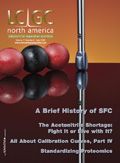57th ASMS Conference Review
LCGC North America
Assistant Editor Megan Evans takes a look back at the annual ASMS Conference that was recently held in Philadelphia.
The 57th ASMS Conference on Mass Spectrometry was held at the Pennsylvania Convention Center, 1101 Arch Street, Philadelphia, Pennsylvania, from May 31st through June 4th, 2009.

(Photo: Getty Images)
The conference began early for some attendees; with several one-and two-day short courses beginning on Saturday May 30th from 9 a.m. to 4:30 p.m., Sunday followed with more short courses and informative tutorial lectures from 5:00 to 6:30 p.m.
Williard H. Harrison gave a tutorial lecture titled, "The Art of Communication in the Sciences." Harrison is Dean Emeritus and a professor in the Department of Chemistry at the University of Florida, Gainseville. He received the Ph.D. degree from the University of Illinois, where his research interests in analytical, optical, and mass spectroscopy took flight. Professor Harrison is a member of the honor society of Phi Kappa Phi, has published 109 research papers, delivered 92 lectures, and presented 138 contributed papers, a number of which were on the topic of glow discharges. Needless to say, Harrison had a wealth of knowledge to offer on the topic of communication in the sciences.
David E. Clemmer, a professor for the chemistry department at Indiana University, gave another tutorial lecture titled, "Ion Mobility in Mass Spectrometry." Professor Clemmer received the Ph.D. in chemistry from the University of Utah and did postdoctoral work at the Himeji Institute of Technology (Japan) and Northwestern University. Professor Clemmer has published more than 135 papers and his work has been recognized with several awards, including the Fresenius Chemistry Award. He has also been a member of the U.S. Defense Science Study group.
Following the tutorial lectures was the official opening session and Plenary Lecture, which featured a talk from Jerald L. Schnoor, of the University of Iowa, entitled, "Biofuels and Global Climate Change." This topic was especially fitting for the June conference as gas prices and temperatures are on the rise once again this summer. Schnoor received the B.S. degree in chemical engineering from Iowa State, the M.S. degree in environmental health engineering, from the University of Texas, and the Ph.D. degree in civil engineering from the University of Texas. Throughout his career, Schnoor has been very active in environmental issues. He testified several times before Congress on the environmental effects of acid deposition and the importance of passing the 1990 Clean Air Act. As Editor-in-Chief of Environmental Science and Technology, Schnoor guided the leading journal in the world in both environmental engineering and environmental science. Professor Schnoor has published (as author, co-author, or editor) six books and over 150 research articles in archival journals, in addition to serving as lead editor of a series of texts and monographs for John Wiley & Sons. His vast array of knowledge and his passion for environmental issues was evident in his lecture. Professor Schnoor was an eloquent speaker and surely set the bar high for the rest of the week with his thought-provoking presentations.
Monday through Thursday were full program days consisting of oral sessions, poster sessions, and workshops. A few popular oral sessions from the week were, "Chromatography-Mass Spectrometry Approaches to Increase Throughput in Discovery PK Assays;" "Mass Spectrometry in Environmental Toxicology;" "Accurate Mass LC–MS Approaches for Characterization and Quantification of Drugs and Metabolites;" "Mass Spectrometry in Homeland Protection;" "LC–MS Assessment of Human Metabolism in Compliance with "MIST" Guidance;" and "Novel LC–MS Techniques for Regulated Bioanalysis of Drugs." These are just a few of the great topics that this year's ASMS covered. All of the sessions were very well researched and offered a lot of practical knowledge to any chromatography or mass spectrometry user.
As always, the staple at ASMS was the hospitality suites, which featured complimentary cocktails, food, and a great atmosphere to meet and greet with fellow colleagues. Philadelphia was a wonderful setting for this conference, which definitely showed its "brotherly love" to all the ASMS conferees. Next year's ASMS conference is scheduled to be in Salt Lake City, Utah — we here at LCGC can't wait to see what next year's program has to offer!

Free Poster: NDSRI Risk Assessment and Trace-Level Analysis of N-Nitrosamines
April 25th 2025With increasing concern over genotoxic nitrosamine contaminants, regulatory bodies like the FDA and EMA have introduced strict guidelines following several high-profile drug recalls. This poster showcases a case study where LGC and Waters developed a UPLC/MS/MS method for quantifying trace levels of N-nitroso-sertraline in sertraline using Waters mass spectrometry and LGC reference standards.
New Guide: Characterising Impurity Standards – What Defines “Good Enough?”
April 25th 2025Impurity reference standards (IRSs) are essential for accurately identifying and quantifying impurities in pharmaceutical development and manufacturing. Yet, with limited regulatory guidance on how much characterisation is truly required for different applications, selecting the right standard can be challenging. To help, LGC has developed a new interactive multimedia guide, packed with expert insights to support your decision-making and give you greater confidence when choosing the right IRS for your specific needs.
Using the Carcinogenic Potency Categorisation Approach (CPCA) to Classify N-nitrosamine Impurities
April 25th 2025Learn how to manage nitrosamine impurities in pharmaceuticals with our free infographic. Discover how the CPCA approach establishes acceptable intake limits and guides the selection of NDSRI reference samples. Stay compliant and ensure safety with our ISO-accredited standards.

.png&w=3840&q=75)

.png&w=3840&q=75)



.png&w=3840&q=75)



.png&w=3840&q=75)









